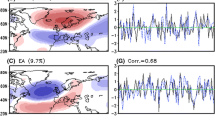Abstract
Based on previous observational studies of the mean atmospheric circulation leading to generalized frosts (GF) in central Southern South America, it is possible to establish a hypothesis that specific large scale patterns are associated to the frequency of occurrence of these events through the propagation of Rossby waves remotely excited. This hypothesis is tested here through a teleconnection analysis for austral winters which present an extreme frequency of occurrence of GF in southeastern South America, particularly over the Wet Pampa area in Argentina. Rossby wave propagation regions are identified for two basic states given by the composition of winters with maximum and minimum frequency of GF occurrence, during the 1961–1990 period. The stationary wavenumber K s indicates the regions where the Rossby wave propagation is permitted and those where it will be inhibited (K s = 0), highlighting the importance of the jets as waveguides. Nevertheless, differences exist between both basic states analyzed. These differences indicate that the locations for wave generation and its later evolution are conditioned by the basic state. Results are validated through a baroclinic model, which simulates the Rossby wave patterns responsible for the teleconnection. Numerical experiments confirm that the principal wave activity takes place inside the subtropical and polar jets. In particular, for the basic state with maximum frequency of GF occurrence, the wave trains propagating inside the subtropical and polar waveguides merge just before entering the continent, as shown by the observations prior to the occurrence of GF events. This configuration favors the development of an intense south wind anomaly with large meridional extension which results in the intensification of anticyclonic circulation in southern South America. A conceptual model is presented to summarise all these results.










Similar content being viewed by others
References
Ambrizzi T, Hoskins BJ (1997) Stationary Rossby wave propagation in a baroclinic atmosphere. Q J R Meteorol Soc 123:919–928
Ambrizzi T, Hoskins BJ, Hsu HH (1995) Rossby wave propagation and teleconnection patterns in the austral winter. J Atmos Sci 52:3661–3672
Berbery EH, Nogués-Paegle J, Horel JD (1992) Wavelike Southern hemisphere extratropical teleconnections. J Atmos Sci 49:155–177
Berbery EH, Vera CS (1996) Characteristics of the Southern hemisphere winter storm track with filtered and unfiltered data. J Atmos Sci 53:468-481
Cavalcanti I (2000) Teleconnection patterns orographically induced in model results and from observational data in the austral winter of the Southern Hemisphere. Int J Climatol 20:1191–1206
Cavalcanti I, Kayano MT (1999) High frequency patterns of the atmospheric circulation over the Southern Hemisphere and South American. Meteorol Atmos Phys 69:179–193
Garreaud RD (2000) Cold air incursions over subtropical South America: mean structure and dynamics. Mon Wea Rev 128:2544–2559
Hoskins BJ (1983) Dynamical processes in the atmosphere and the use of models. Q J R Meteorol Soc 109:1–21
Hoskins BJ, Ambrizzi T (1993) Rossby wave propagation on a realistic longitudinally varying flow. J Atmos Sci 50:1661–1671
Hoskins BJ, Karoly DJ (1981) The steady linear responses of a spherical atmosphere to thermal and orographic forcing. J Atmos Sci 38:1179–1196
Hoskins BJ, Simmons AJ (1975) A multi-layer spectral model and the semi-implicit method. Q J R Meteorol Soc 101:637–655
Jin FF, Hoskins BJ (1995) The direct response to tropical heating in a baroclinic atmosphere. J Atmos Sci 52:307–319
Karoly DJ (1983) Rossby wave propagation in a barotropic atmosphere. Dyn Atmos Oceans 7:111–125
Kiladis GN (1998) Observations of Rossby waves linked to convection over the eastern tropical Pacific. J Atmos Sci 55:321–339
Marengo JA, Cornejo A, Satyamurty P, Nobre C, Sea W (1997) Cold surges in tropical and extratropical South America: the strong event in June 1994. Mon Wea Rev 125:2759–2786
Marengo JA, Ambrizzi T, Kiladis G, Liebmann B (2002) Upper-air wave trains over the Pacific Ocean and wintertime cold surges in tropical-subtropical South America leading to freezes in Southern and Southeastern Brazil. Theor Appl Climate 74:243–247
Müller GV (2006) Variabilidad Interanual de las Heladas en la Pampa Húmeda. Braz J Meteorol 21:135–141
Müller GV, Ambrizzi T (2006) Teleconnection patterns associated with extreme frequency of Generalized Frosts. Part II: Origin and evolution of the Rossby waves propagation patterns in the Austral Hemisphere’. In: 8th International conference on southern hemisphere meteorology and oceanography. Foz do Iguazu, Brasil
Müller GV, Berri GJ (2007) Atmospheric circulation associated with persistent generalized frosts in central-southern South America. Mon Wea Rev 135(4):1268–1289
Müller GV, Nuñez MN, Seluchi ME (2000) Relationship between ENSO cycles and frosts events within the Pampa Húmeda region. Int J Climatol 20:1619–1637
Müller GV, Ambrizzi T, Núñez MN (2005) Mean atmospheric circulation leading to generalized frosts in Central Southern South America. Theor Appl Climate 82:95–112
Seluchi ME, Marengo JA (2000) Tropical-midlatitude exchange of air masses during summer and winter in South America: climatic aspects and examples of intense events. Int J Climatol 20:1167–1190
Valdes PJ, Hoskins BJ (1989) Linear stationary wave simulations of the time-mean climatological flow. J Atmos Sci 46:2509–2527
Vera CS, Vigliarolo PK (2000) A diagnostic study of cold-air outbreaks over South America. Mon Wea Rev 128:3–24
Yang GY, Hoskins BJ (1996) Propagation of Rossby waves of nonzero frequency. J Atmos Sci 53:2365–2378
Acknowledgments
We are grateful to Dr George Kiladis and to an anonymous reviewer for their suggestions, which contributed to improve this work. GM is also grateful for the CNPq grant no. 152039/2004-0. TA had also partial support from CNPq, FAPESP and IAI-CRN055. This paper is part of the first author’s PhD Thesis at the University of Buenos Aires.
Author information
Authors and Affiliations
Corresponding author
Rights and permissions
About this article
Cite this article
Müller, G.V., Ambrizzi, T. Teleconnection patterns and Rossby wave propagation associated to generalized frosts over southern South America. Clim Dyn 29, 633–645 (2007). https://doi.org/10.1007/s00382-007-0253-x
Received:
Accepted:
Published:
Issue Date:
DOI: https://doi.org/10.1007/s00382-007-0253-x




